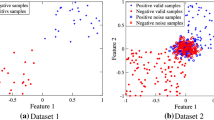Abstract
Regularized least squares twin support vector machines are a new nonparallel hyperplane classifier, which can lead to simple and fast algorithms for generating binary classifiers by replacing inequality constraints with equality constraints and implementing the structural risk minimization principle in twin support vector machines. Multi-view learning is an emerging direction in machine learning which aims to exploit distinct views to improve generalization performance from multiple distinct feature sets. Experimental results demonstrate that our proposed methods are effective.
Similar content being viewed by others
Explore related subjects
Discover the latest articles, news and stories from top researchers in related subjects.References
Shawe-Taylor J, Sun S (2011) A review of optimization methodologies in support vector machines. Neurocomputing 74(17):3609–3618
Vapnik V (1995) The nature of statistical learning theory. Springer-Verlag, New York
Christianini N, Shawe-Taylor J (2002) An introduction to support vector machines. Cambridge University Press, Cambridge
Burges C (1998) A tutorial on support vector machines for pattern recognition. Data Min Knowl Discov 2:121–167
Ripley B (1996) Pattern recognition and neural networks. Cambridge University Press, Cambridge
Scholkopf B, Smola A. (2003) Learning with Kernels. MIT Press, Cambridge
Ghorai S, Mukherjee A, Dutta P (2009) Nonparallel plane proximal classifier. Signal Process 89 (4):510–522
Mangasarian O, Wild E (2006) Multisurface proximal support vector machine classification via generalized eigenvalues. IEEE Trans Pattern Anal Mach Intell 28(1):69–74
Jayadeva K, Khemchandani R, Chandra S (2007) Twin support vector machines for pattern classification. IEEE Trans Pattern Anal Mach Intell 29(5):905–910
Kumar M, Gopal M (2009) Least squares twin support vector machines for pattern classification. Expert Syst Appl 36:7535–7543
Xu Y, Xi W, Lv X, Guo R (2012) An improved least squares twin support vector machine. J Inf Comput Sci 9:1063–1071
Zhao J, Xie X, Xin X, Sun S (2017) Multi-view learning over- view: Recent progress and new challenges. Information Fusion. https://doi.org/10.1016/j.inffus.2017.02.007
Blum A, Mitchell T (1998) Combining labeled and unlabeled data with co-training. In: Proceedings of the 11th Annual Conference on Computational Learning Theory, pp 92–100
Nigam K, Ghani R (2000) Analyzing the effectiveness and applicability of co-training. In: Proceedings of the 9th International Conference on Information and Knowledge Management, pp 86–93
Muslea I, Minton S, Knoblock C (2006) Active learning with multiple views. J Artif Intell Res 27:203–233
Sun S, Jin F (2011) Robust co-training. Int J Pattern Recogn Artif Intell 25:1113–1126
Farquhar J, Hardoon D, Shawe-Taylor J, Szedmak S (2006) Two view learning: SVM-2K, theory and practice. Adv Neural Inf Process Syst 18:355–362
Sun S, Shawe-Taylor J (2010) Sparse semi-supervised learning using conjugate functions. J Mach Learn Res 11:2423–2455
Xie X, Sun S (2015) Multi-view twin support vector machines. Intell Data Anal 19:701–712
Bartlett P, Mendelson S (2002) Rademacher and Gaussian complexities: risk bounds and structural results. J Mach Learn Res 3:463–482
Sun S, Shawe-Taylor J, Mao L (2017) PAC-Bayes analysis of multi-view learning. Inf Fusion 35:117–131
Sun S, Chao G (2013) Multi-view maximum entropy discrimination. In: Proceedings of the 23rd International Joint Conference on Artificial Intelligence, pp 1706–1712
Chao G, Sun S (2016) Alternative multi-view maximum entropy discrimination. IEEE Trans Neural Netw Learn Syst 27:1445–1456
Mao L, Sun S (2016) Soft margin consistency based scalable multi-view maximum entropy discrimination. In: Proceedings of the 25th International Joint Conference on Artificial Intelligence, pp 1839–1845
Chao G, Sun S (2016) Consensus and complementarity based maximun entropy discrimination for multi-view classification. Inf Sci 367:296–310
Acknowledgments
This work is supported by Ningbo University talent project 421703670 as well as programs sponsored by K.C. Wong Magna Fund in Ningbo University. It is also supported by the Zhejiang Provincial Department of Education under Projects 801700472. It is also supported by the Natural Science Foundation of Zhejiang Province under Projects LQ18F020001.
Author information
Authors and Affiliations
Corresponding author
Rights and permissions
About this article
Cite this article
Xie, X. Regularized multi-view least squares twin support vector machines. Appl Intell 48, 3108–3115 (2018). https://doi.org/10.1007/s10489-017-1129-3
Published:
Issue Date:
DOI: https://doi.org/10.1007/s10489-017-1129-3




